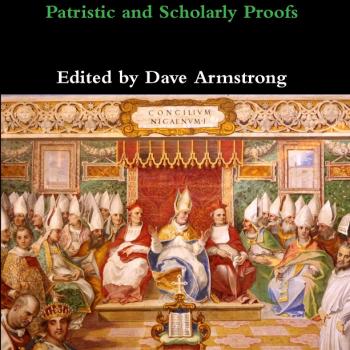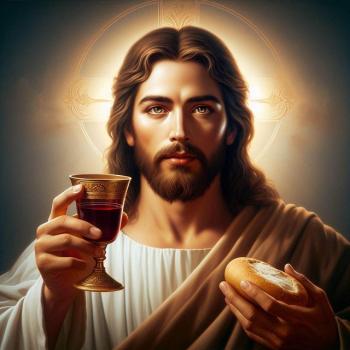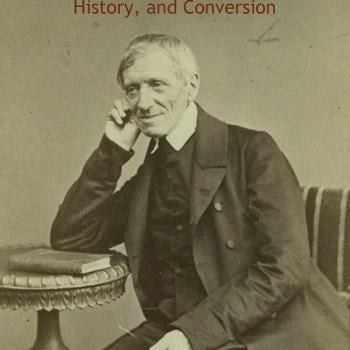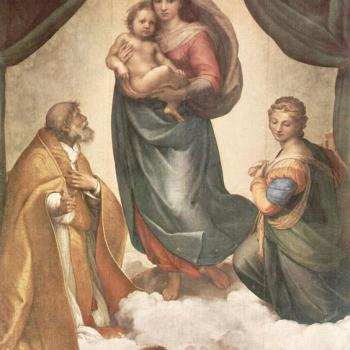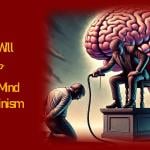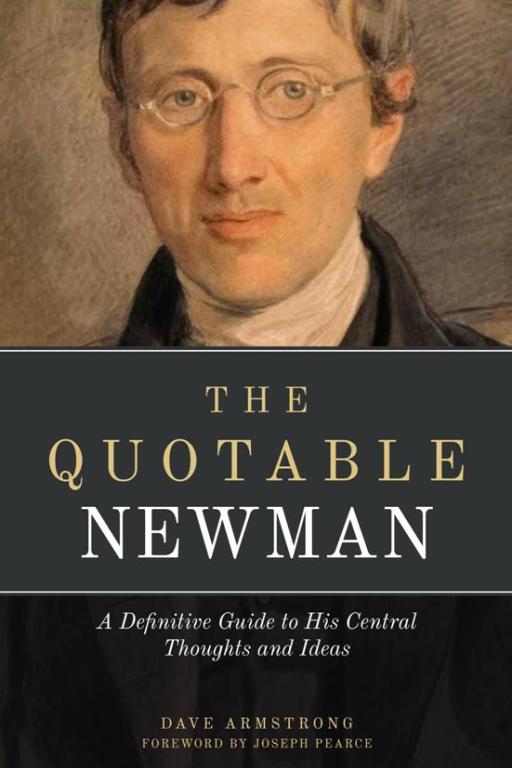
See the related article, Mary’s Sinlessness & the Fathers (vs. Javier Perdomo) . . . Including a Turn the Tables Argument Regarding Protestant Doctrines Virtually Nonexistent in the Fathers (Sola Scriptura, Sola Fide) [2-5-25]: to which this is a follow-up. All the words in the first section (before the ++++++’s) are St. John Henry Cardinal Newman’s own. I make a few additional brief observations at the end.
*****
If I am asked for proof of the doctrine being held in the early Church, I answer that it seems included in the general belief that the Blessed Virgin was without sin – and, while not much is said about her at all, when she is spoken of, she is spoken of in this aspect. I need not do more than remind you of the well known passage of St Augustine, in which he says that, when Mary is named, he does not wish to make any mention of sin, as if the two names were antagonistic – but what to me is, and ever has been, most striking, is the series of passages from the earliest Fathers in which Mary is contrasted to Eve, as typical contrasts. St Justin (A.D 160) St Irenaeus (A.D. 170) Tertullian (A.D 200) all enlarge on this contrast – and later Fathers hand down the Tradition. The very point indeed in which the contrast is made, is that of obedience – but, when St Irenaeus says, ’mankind is surrendered to death by a Virgin, and is saved by a Virgin,’ he surely implies that as Eve was without sin, so was Mary. Why indeed is it difficult to suppose that Mary had at least the privilege of Eve? – and Eve had an immaculate conception and birth. . . . I think I am right in saying, that the only great historical difficulty of the doctrine is the opposition, if it may be so called, of St Bernard and St Thomas – yet to my mind it is clearly shown that they did not mean by the doctrine what the Church now means . . . the two saints in question were opposing what no one now thinks of maintaining . . . (The Letters and Diaries of John Henry Newman, vol. 19; To Arthur Osborne Alleyne, 30 May 1860)
You will ask perhaps, ‘Why then was there so much controversy about the doctrine or about its definition?’ . . . I do not see any difficulty in the matter. From the beginning of the Church even good and holy men have got involved in controversies of words. . . . The devotion to her has gradually and slowly extended through the Church; the doctrine about her being always the same from the first. But the gradual growth of the devotion was a cause why that doctrine, in spite of its having been from the first, should have been but slowly recognised, slowly defined. . . . ‘The new devotion was first heard of in the ninth century.’ Suppose I say, ‘The new doctrine of our Lord’s immensity, contradicted by all the Ante-nicene Fathers, was first heard of in the creed of St Athanasius?’ or ‘The Filioque, protested against by the Orthodox Church to this day, was first heard of in the 7th Century?’ Whatever principle is adduced to explain the latter statement will avail for the first. . . . The Holy Ghost’s eternity is involved in His divinity; the Blessed Virgin’s immaculateness in her conception is involved in the general declarations of the Fathers about her sinlessness. If all Catholics have not seen this at once, we must recollect that there were at first mistakes among pious and holy men about the attributes of the Holy Spirit. . . . I fully grant that there is not that formal documentary evidence for the doctrine in question which there is for some other doctrines, but I maintain also that, from its character, it does not require it. (The Letters and Diaries of John Henry Newman, vol 19; To Arthur Osborne Alleyne, 15 June 1860)
I ask you, have you any intention to deny that Mary was as fully endowed as Eve? is it any violent inference, that she, who was to co-operate in the redemption of the world, at least was not less endowed with power from on high, than she who, given as a help-mate to her husband, did in the event but cooperate with him for its ruin? If Eve was raised above human nature by that indwelling moral gift which we call grace, is it rash to say that Mary had even a greater grace? And this consideration gives significance to the Angel’s salutation of her as “full of grace,”—an interpretation of the original word which is undoubtedly the right one, as soon as we resist the common Protestant assumption that grace is a mere external approbation or acceptance, answering to the word “favour,” whereas it is, as the Fathers teach, a real inward condition or superadded quality of soul.
And if Eve had this supernatural inward gift given her from the first moment of her personal existence, is it possible to deny that Mary too had this gift from the very first moment of her personal existence? I do not know how to resist this inference:—well, this is simply and literally the doctrine of the Immaculate Conception. I say the doctrine of the Immaculate Conception is in its substance this, and nothing more or less than this (putting aside the question of degrees of grace); and it really does seem to me bound up in the doctrine of the Fathers, that Mary is the second Eve. . . .
It has no reference whatever to her parents, but simply to her own person; it does but affirm that, together with the nature which she inherited from her parents, that is, her own nature, she had a superadded fulness of grace, and that from the first moment of her existence. Suppose Eve had stood the trial, and not lost her first grace; and suppose she had eventually had children, those children from the first moment of their existence would, through divine bounty, have received the same privilege that she had ever had; that is, as she was taken from Adam’s side, in a garment, so to say, of grace, so they in turn would have received what may be called an immaculate conception. They would have then been conceived in grace, as in fact they are conceived in sin. What is there difficult in this doctrine? What is there unnatural? Mary may be called, as it were, a daughter of Eve unfallen.
You believe with us that St. John Baptist had grace given to him three months before his birth, at the time that the Blessed Virgin visited his mother. He accordingly was not immaculately conceived, because he was alive before grace came to him; but our Lady’s case only differs from his in this respect, that to her the grace of God came, not three months merely before her birth, but from the first moment of her being, as it had been given to Eve. . . . they fancy that we ascribe a different nature from ours to the Blessed Virgin, different from that of her parents, and from that of fallen Adam. We hold nothing of the kind; we consider that in Adam she died, as others; that she was included, together with the whole race, in Adam’s sentence; that she incurred his debt, as we do; but that, for the sake of Him who was to redeem her and us upon the Cross, to her the debt was remitted by anticipation, on her the sentence was not carried out, except indeed as regards her natural death, for she died when her time came, as others. All this we teach, but we deny that she had original sin; . . . Mary could not merit, any more than they, the restoration of that grace; but it was restored to her by God’s free bounty, from the very first moment of her existence, and thereby, in fact, she never came under the original curse, which consisted in the loss of it.
And she had this special privilege, in order to fit her to become the Mother of her and our Redeemer, to fit her mentally, spiritually for it; so that, by the aid of the first grace, she might so grow in grace, that, when the Angel came and her Lord was at hand, she might be “full of grace,” prepared as far as a creature could be prepared, to receive Him into her bosom. I have drawn the doctrine of the Immaculate Conception, as an immediate inference, from the primitive doctrine that Mary is the second Eve. The argument seems to me conclusive . . . (Letter to Pusey, ch. 3, 1865; paragraph breaks my own)
As to the antiquity of the doctrine. In the first ages original sin was not. formally spoken of in contrast to actual. In the fourth century, Pelagius denied it, and was refuted and denounced by St Augustine. Not till the time of St Augustine could the question be mooted precisely whether our Lady was without original sin or not. Up to his time, and after his time, it was usual to say or to imply that Mary had nothing to do with sin, in vague terms. The earliest Fathers, St Justin, St Irenaeus etc. contrast her with Eve, while they contrast our Lord with Adam. In doing this – 1. they, sometimes imply, sometimes insist upon, the point that Eve sinned when tried, and Mary did not sin when tried; and 2. they say that, by not sinning, Mary had a real part in the work of redemption, in a way in which no other creature had a share. This does not go so far as actually to pronounce that she had the grace of God from the first moment of her existence, and never was under the power of original sin, but by comparing her with Eve, who was created of course without original sin, and by giving her so high an office, it implies it. Next, shortly after St Augustine, the 3rd General Council was held against Nestorius, and declared Mary to be the Mother of God. From this time the language of the Fathers is very strong, though vague, about her immaculateness. In the time of Mahomet the precise doctrine seems to have been taught in the East, for I think he mentions it in the Koran. In the middle ages, when everything was subjected to rigid examination of a reasoning character, the question was raised whether the doctrine was consistent with the Blessed Virgin’s having a human father and mother – and serious objections were felt to it on this score. Men defined the words ’Immaculate Conception’ differently from what I have done above, and in consequence denied it. St Bernard and St Thomas, in this way, were opposed to it, and the Dominicans. A long controversy ensued and a hot one – it lasted many centuries. At length, in our time, it has been defined in that sense in which I have explained the words above – a sense, which St Bernard, St Thomas, and the Dominicans did not deny. The same controversy about the sense of a word had occurred in the instance of the first General Council at Nicaea. The Nicene Creed uses the word ’Consubstantial’ to protect the doctrine of our Lord’s divinity against Arius, which the great Council of Antioch some 70 years before had repudiated as a symbol of heresy. In like manner great Saints have repudiated the words ’Immaculate Conception,’ from taking them in a different sense from that which the Church has accepted and sanctioned. (The Letters and Diaries of John Henry Newman, vol. 22; To Lady Chatterton, 2 Oct. 1865)
Of course the comparison between Eve and Mary is in all the Fathers ’mystical throughout,’ not literal. Our Lord is Adam mystically – and Mary is Eve. Unless there is a likeness, there would be no mystical relation. The Lamb of God, the King of Israel, the Elias that was to come, the New Jeru salem are all mystical; but we interpret the new by the old. We say that our Lord was a sacrifice, because he was mystically a Lamb – and Mary sinless because she was mystically Eve. (The Letters and Diaries of John Henry Newman, vol. 22; To Robert Charles Jenkins, 26 Feb. 1866)
That the Immaculate Conception was in the depositum seems to me clear, as soon as it is understood what the doctrine is. I have drawn out the argument in my “Letter to Dr. Pusey.” The Fathers from the beginning call Mary the Second Eve. This has been the dogma proclaimed by the earliest Fathers. There are three especially witnesses to [it] in three or four or five countries widely separated. St. Justin Martyr speaks for Syria, St. Irenaeus for Asia Minor and Gaul, and Tertullian for Rome and Africa. Nothing is included in the doctrine of the Immaculate Conception which is not included in the Eve character of Mary—nay, not so much, for Eve in Paradise did not need redemption, but Mary was actually redeemed by the blood of her Son so much as any of us, and the grace she had was not like Eve’s grace in Paradise, but simply a purchased grace. (Letter to Mrs. William Froude, March 1871; in Wilfrid Ward, The Life of John Henry Cardinal Newman, vol. 2, 1912, 376-377)
This is what is often called development of doctrine. It is no where said e.g., by the early Fathers, that Mary was without sin – but they do say that she is the second Eve, and that also she is the contrary to Eve in not having fallen; from which the Church, under the gift of infallibility, deduces her sinlessness. (The Letters and Diaries of John Henry Newman, vol. 27, 84; Letter to J. H. Willis Nevins, 25 June 1874)
That “Mary is the new Eve,” . . . is an explicit tradition; and by the force of it follow two others, which are implicit:—first (considering the condition of Eve in paradise), that Mary had no part in sin, and indefinitely large measures of grace; secondly (considering the doctrine of merits), that she has been exalted to glory proportionate to that grace. (Note III for Letter to Pusey, in Certain Difficulties Felt by Anglicans in Catholic Teaching Considered, vol. 2, 1875)
The early teaching was that Mary was the ‘Second Eve –’ now Eve was filled with grace from the moment she was taken from Adam’s side – and this is just the doctrine of the Immaculate Conception. (The Letters and Diaries of John Henry Newman, vol. 28, 129; Letter to John Douglas Sandford, 21 Oct. 1876)
Now, as to the doctrine of the Immaculate Conception, it was implied in early times, and never denied. In the Middle Ages it was denied by St. Thomas and by St. Bernard, but they took the phrase in a different sense from that in which the Church now takes it. They understood it with reference to our Lady’s mother, and thought it contradicted the text, “In sin hath my mother conceived me”—whereas we do not speak of the Immaculate Conception except as relating to Mary; and the other doctrine (which St. Thomas and St. Bernard did oppose) is really heretical. . . . Consider what I have said. Is it, after all, certainly irrational? is it certainly against Scripture? is it certainly against the primitive Fathers? is it certainly idolatrous? I cannot help smiling as I put the questions. Rather, may not something be said for it from reason, from piety, from antiquity, from the inspired text? . . . Many, many doctrines are far harder than the Immaculate Conception. The doctrine of Original Sin is indefinitely harder. Mary just has not this difficulty. It is no difficulty to believe that a soul is united to the flesh without original sin; the great mystery is that any, that millions on millions, are born with it. Our teaching about Mary has just one difficulty less than our teaching about the state of mankind generally. (Meditations and Devotions of the Late Cardinal Newman, edited by William P. Neville; London: Longmans, Green, and Co., 1907, “Memorandum on the Immaculate Conception”)
+++++++++++++++++++++++++++++++++++++++++++++++++++++++++++++++++++++++++++++++++++++++++++++++++
1) Many Church fathers (including, notably, St. Augustine) held that Mary was free of actual sin, but not of original sin. I have argued that the essence of the Immaculate Conception was sinlessness. Cdl. Newman contended several times above that the analogy to Eve (Second or New Eve) presupposes Mary’s sinlessness, because Eve was created sinless, and Mary in effect “undid” Eve’s subsequent sin and fall. She was the “Eve” who said yes to God instead of no. But the extension of her being without actual sin to being free of original sin can easily and plausibly be regarded as a better understood development of her freedom from sinlessness.
2) Related to #1 and also mentioned by Cdl. Newman is the fact that the doctrine of original sin itself (explicitly attested to in very few passages in Holy Scripture) was slow to develop; basically taking until Augustine’s time in the late 4th century (and there were also east-west differences that have existed ever since). Obviously, then, patristic quotes before this time would not have been taking it into account.
3) It poses no problem for Catholicism if some Church fathers simply were wrong about this doctrine or any other that we believe in. St. Augustine was wrong, for example, about double predestination. But in any event, we don’t regard the Church fathers (especially not as individuals) as infallible. Even “unanimous consent” of the fathers doesn’t literally mean that, in the Latin. It means “overall consensus.” The Church fathers aren’t part of the Catholic magisterium (our basis of ecclesial authority). That would be the pope, when he indicates that he is making a binding proclamation of dogma, and bishops collectively in an ecumenical council, in agreement with the pope. But we do think it’s significant and an indication of the presence of sacred tradition and the apostolic deposit in cases where they exhibit an overwhelming consensus regarding a doctrine.
4) As I contended in my previous related paper, doctrines develop at different rates of speed, and this is one that was relatively slower, largely because of, I think, the fact that Jesus was front and center, both in the New Testament and in the fathers in the earlier centuries. But as an analogy, trinitarianism also took about the same length of time to fully develop. I wrote:
The Christological heresy of Monophysitism was still present in the 6th century, and Monothelitism extended all the way to the Third Council of Constantinople in 681, where it was condemned. . . . Andrew of Crete (c. 660-740) wrote about how “human nature . . . regains in her person its ancient privileges and is fashioned according to a perfect model truly worthy of God” (Homily 1 on Mary’s Nativity) . . . Marian scholar Hilda Graef, a source that appeared once in your article, noted that “according to John of Damascus [c. 675-749], even the ‘active’ conception of Mary was completely without stain . . .”: a position that even goes beyond what the Catholic dogma holds (which is that her immaculate conception had nothing to do with her parents at all). Thus, these last two writers express pretty much the fully developed doctrine of Mary’s Immaculate Conception, around the same time as trinitarian debates were wrapping up, or only shortly thereafter. So Catholics ask Protestants, in Newmanian analogical style: “if even trinitarianism was fully developed as late as 681, why is it an issue that Mary’s Immaculate Conception was first explicitly expressed (as far as we know) around the same time?” If one thing is okay, so is the other. One can’t accept late development only of Protestant distinctives or doctrines where we agree. The same analysis and standard has to be used across the board.
5) The time of ensoulment also had to wait until a proper understanding of biology was achieved, and it’s still held in faith because science per se (based on empiricism) doesn’t deal with souls. Many through the centuries thought that it occurred at quickening, or the detection of movement in a preborn child. This was what St. Thomas Aquinas got wrong. Even Martin Luther’s later view (sometime after 1527) — which I have researched in great detail — partially depended on this distinction, and/or held that Mary’s purification from both actual and original sin occurred at the conception of Christ, not her own. Many Lutheran scholars contend that Luther held to the doctrine of the Immaculate Conception his entire life. Others — I agree with them — think he changed to a somewhat different view later on. I have called his later position, “Immaculate Purification.”
6) A key aspect of the Catholic doctrine involves the idea of “pre-redemption”: meaning that Mary was still saved from sin like we all are because God prevented — by an extraordinary act of grace at her conception — what would have been an inevitable inheritance of original sin, and very likely also actual sin as a consequence. This is why Mary can refer to God as her savior, without contradiction to our doctrine. Duns Scotus (c. 1365-1408) is credited with this insight.
7) Related to #6 is a sense in which Mary did inherit original sin by being conceived. But God chose to intervene because she was the mother of God the Son, and it was fitting to do so (itself a biblical concept, as I have shown). Assume for the sake of argument that Mary actually inherited original sin for a nanosecond before God performed His special act of grace. Whether that happened or not, still we know that she definitely would have inherited it had God not acted. The very act on His part shows that it was necessary to prevent such an inheritance. In this specific sense one can incorporate all of the statements from the fathers saying that inheritance of original sin was universal, without any harm to the Catholic doctrine.
I could probably think of a few more general observations if I kept pondering it, but as I said in my previous article, I don’t intend to make a full reply. My main point that I want to get across is to note that the issue is not nearly as simple as merely a compilation of all the citations Javier found; because they have to be understood and interpreted in historical context (and each fathers’ other writings as well, because they can develop or change) and subjected to the qualifiers I have brought up.
*
***
*
Photo credit: cover of my 2012 book, published by Sophia Institute Press (see book & purchase info.).
Summary: Lutheran apologist Javier Perdomo’s claims that the Church fathers contradict Mary’s sinlessness and Immaculate Conception. I respond with Newman & a few more thoughts.




